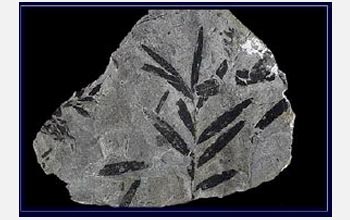News Release 09-126
Sudden Collapse in Ancient Biodiversity: Was Global Warming the Culprit?
Scientists discover early warning signs of ecosystems at risk

Ancient fossil leaves tell a story of sudden loss of biodiversity that may have future parallels.
June 18, 2009
This material is available primarily for archival purposes. Telephone numbers or other contact information may be out of date; please see current contact information at media contacts.
Scientists have unearthed striking evidence for a sudden ancient collapse in plant biodiversity. A trove of 200 million-year-old fossil leaves collected in East Greenland tells the story, carrying its message across time to us today.
Results of the research appear in this week's issue of the journal Science.
The researchers were surprised to find that a likely candidate responsible for the loss of plant life was a small rise in the greenhouse gas carbon dioxide, which caused Earth's temperature to rise.
Global warming has long been considered as the culprit for extinctions--the surprise is that much less carbon dioxide gas in the atmosphere may be needed to drive an ecosystem beyond its tipping point than previously thought.
"Earth's deep time climate history reveals startling discoveries that shake the foundations of our knowledge and understanding of climate change in modern times," says H. Richard Lane, program director in the National Science Foundation (NSF)'s Division of Earth Sciences, which partially funded the research.
Jennifer McElwain of University College Dublin, the paper's lead author, cautions that sulfur dioxide from extensive volcanic emissions may also have played a role in driving the plant extinctions.
"We have no current way of detecting changes in sulfur dioxide in the past, so it's difficult to evaluate whether sulfur dioxide, in addition to a rise in carbon dioxide, influenced this pattern of extinction," says McElwain.
The time interval under study, at the boundary of the Triassic and Jurassic periods, has long been known for its plant and animal extinctions.
Until this research, the pace of the extinctions was thought to have been gradual, taking place over millions of years.
It has been notoriously difficult to tease out details about the pace of extinction using fossils, scientists say, because fossils can provide only snap-shots or glimpses of organisms that once lived.
Using a technique developed by scientist Peter Wagner of the Smithsonian Institution National Museum of Natural History in Washington, D.C., the researchers were able to detect, for the first time, very early signs that these ancient ecosystems were already deteriorating--before plants started going extinct.
The method reveals early warning signs that an ecosystem is in trouble in terms of extinction risk.
"The differences in species abundances for the first 20 meters of the cliffs [in East Greenland] from which the fossils were collected," says Wagner, "are of the sort you expect. "But the final 10 meters show dramatic loses of diversity that far exceed what we can attribute to sampling error: the ecosystems were supporting fewer and fewer species."
By the year 2100, it's expected that the level of carbon dioxide in the modern atmosphere may reach as high as two and a half times today's level.
"This is of course a 'worst case scenario,'" says McElwain. "But it's at exactly this level [900 parts per million] at which we detected the ancient biodiversity crash.
"We must take heed of the early warning signs of deterioration in modern ecosystems. We've learned from the past that high levels of species extinctions--as high as 80 percent--can occur very suddenly, but they are preceded by long interval of ecological change."
The majority of modern ecosystems have not yet reached their tipping point in response to climate change, the scientists say, but many have already entered a period of prolonged ecological change.
"The early warning signs of deterioration are blindingly obvious," says McElwain. "The biggest threats to maintaining current levels of biodiversity are land use change such as deforestation. "But even relatively small changes in carbon dioxide and global temperature can have unexpectedly severe consequences for the health of ecosystems."
The paper, "Fossil Plant Relative Abundances Indicate Sudden Loss of Late Triassic Biodiversity in East Greenland," was co-authored by McElwain, Wagner and Stephen Hesselbo of the University of Oxford in the U.K.
-NSF-
-
Fossil leaves were collected by the research team from a site in East Greenland.
Credit and Larger Version -
The researchers' findings are published in the June 19, 2009, issue of the journal Science.
Credit and Larger Version
Media Contacts
Cheryl Dybas, NSF, (703) 292-7734, email: cdybas@nsf.gov
The U.S. National Science Foundation propels the nation forward by advancing fundamental research in all fields of science and engineering. NSF supports research and people by providing facilities, instruments and funding to support their ingenuity and sustain the U.S. as a global leader in research and innovation. With a fiscal year 2023 budget of $9.5 billion, NSF funds reach all 50 states through grants to nearly 2,000 colleges, universities and institutions. Each year, NSF receives more than 40,000 competitive proposals and makes about 11,000 new awards. Those awards include support for cooperative research with industry, Arctic and Antarctic research and operations, and U.S. participation in international scientific efforts.
Connect with us online
NSF website: nsf.gov
NSF News: nsf.gov/news
For News Media: nsf.gov/news/newsroom
Statistics: nsf.gov/statistics/
Awards database: nsf.gov/awardsearch/
Follow us on social
Twitter: twitter.com/NSF
Facebook: facebook.com/US.NSF
Instagram: instagram.com/nsfgov




